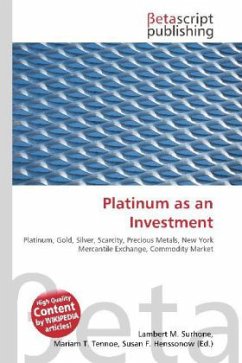Please note that the content of this book primarily consists of articles available from Wikipedia or other free sources online. Platinum has a much shorter history in the financial sector than either gold or silver, which were known to ancient civilizations. Platinum is relatively scarce even among the precious metals. New mine production totals approximately only 5 million troy ounces (150 Mg) a year. In contrast, gold mine production runs approximately 82 million ounces (2550 Mg) a year, and silver production is approximately 547 million ounces (17000 Mg). As such, it tends to trade at higher per-unit prices. Platinum is traded on the New York Mercantile Exchange (NYMEX) and the London Platinum and Palladium Market. To be saleable on most commodity markets, platinum ingots must be assayed and hallmarked in a manner similar to the way gold and silver are. The price of platinum changes along with its supply and demand. During periods of sustained economic stability and growth, the price of platinum tends to be as much as twice the price of gold, whereas, during periods of economic uncertainty, the price of platinum tends to decrease because of reduced demand, falling below the price of gold, partly due to increased gold prices.
Bitte wählen Sie Ihr Anliegen aus.
Rechnungen
Retourenschein anfordern
Bestellstatus
Storno








